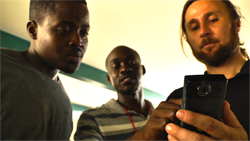David Barnhart has a unique calling within Presbyterian Church (U.S.A.). He’s a storyteller. More specifically, Barnhart is a director and producer of documentaries such as Kepulihan: Stories from the Tsunami, and he’s often called to disaster areas by Presbyterian Disaster Assistance (PDA) to connect with those affected. He often provides an outlet for those who simply want to tell their story.
“It has been my experience that stories have the capacity to heal, connect people, and reveal our common humanity across cultural, religious, and socioeconomic barriers and boundaries,” he recently wrote.

Director and producer David Barnhart demonstrates how the flip cams interface with computers. —Photo Credit: Scott Ippolito, PDA
Barnhart, with the help of cinematographer, Scott Ippolito and editor, Joshua Borger, is now working on a new project following the lives of Haitians impacted by the 2010 earthquake. As part of that effort, the trio is approaching storytelling in an extraordinary way. They have provided flip cams to survivors. (See inset for “reporter” script.)
“Through the Flip Cam Story Project we hope to empower survivors to document their own stories of healing, struggle, and transformation by placing the cameras and storytelling in their hands,” Barnhart wrote.
“[This] enables them to move from being objects of a disaster to active subjects of a daily, unfolding story of recovery.”

One of the Haiti’s “reporters” practices using the flip cam on cinematographer Scott Ippolito. —Photo Credit: David Barnhart, PDA
Portions of these stories will be shared in the coming weeks, months, and years on the General Assembly Mission Council’s Haiti web page. Below is a first look at the project as those who will act as “reporters” in Haiti are shown how to handle interviews and use the flip cams. We hope you’ll accept the invitation to learn more about the people of Haiti in a way rarely experienced and follow this one-of-a-kind project.
Watch a demonstration of the project online.
Reporting from Haiti
The below “script” was given to each participant taking part in the Flip Cam Story Project. The portions in English are followed by Creole, the native language in Haiti. Barnhart and Ippolito also trained each person on how to use the cameras:
You are a reporter on the ground who is telling the story of earthquake recovery from your perspective and those of your family and community. The 'story' of recovery is not just facts, but reflections about progress, struggles, hopes, challenges, achievements, and how things are changing every day. What steps and progress do you see? What struggles and challenges remain? Share the story of day to day life and recovery in your words and the reflections of other survivors in your community.
Ou se yon jounalis, yon jounalis lakay epi nou bezwen pou ou rakonte istwa ou a ansanm ak istwa kominote ou a. Istwa sa yo, se istwa sou ki jan n ap rekipere apre tranbleman tè a. Nou bezwen pou nou rakonte istwa sa jan nou menm nou wè l. Nou pa bezwen konnen sa lòt moun panse, nou bezwen konnen sa nou menm menm panse, sa nou menm menm ap viv, esperyans ou menm ak esperyan fanmi ou, ak esperyans kominote ou.
The 'story' of recovery is not just facts, but reflections about progress, struggles, hopes, challenges, achievements, and how things are changing every day. What steps and progress do you see? What struggles and challenges remain?

Two "reporters" practice using the flip cam. —Photo Credit: David Barnhart, PDA
Istwa nou bezwen pou nou rakonte a, se pa selman sa k ap pase, sa k ap fèt. Nou bezwen tande tout sa n ap reflechi a, tout sa nou panse. Sa nou panse sou pwogre k ap fèt, sa nou panse sou lit nou a, sou espwa nou genyen yo, sou defi nou genyen epi sou sa nou gentan akonpli. Nou bezwen konnen sou ki jan bagay yo ap chanje jou an jou. Ki sa nou wè k ap amelyore? Ki objektif ak defi ki rete?
Share the story of day to day life and recovery in your words and the reflections of other survivors in your community.
Nou vle pou nou pataje lavi nou a, chak jou. Nou vle tande ki jan rekiperasyon ap mache pou nou. Nou vle tande pwòp pawòl nou yo ansanm avèk tout reflechisman lòt moun nan kominote ou yo, sa tout moun ki te siviv eveneman terib sa a, ki sa yo wè ak sa yo pan.

